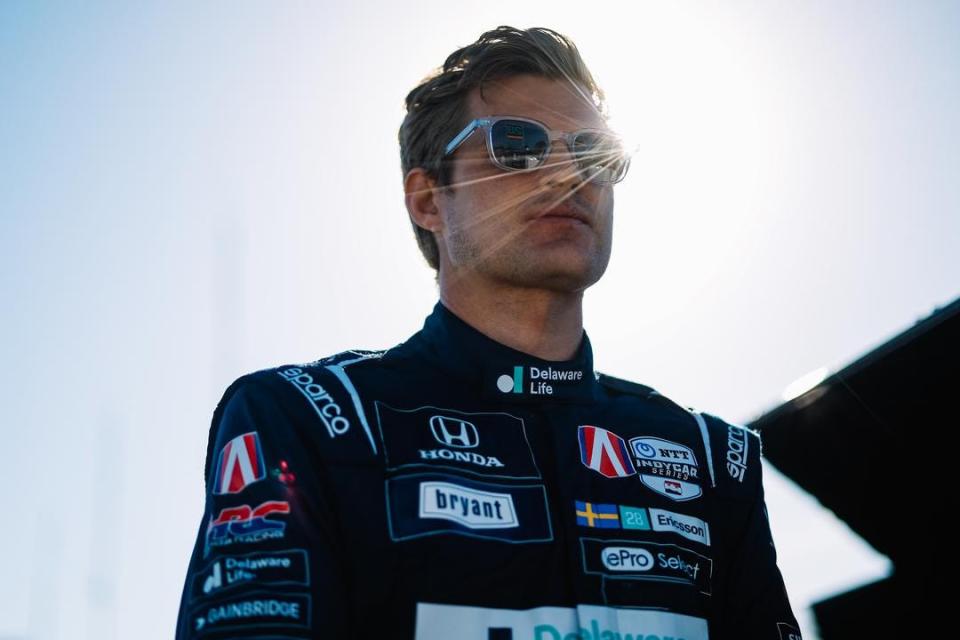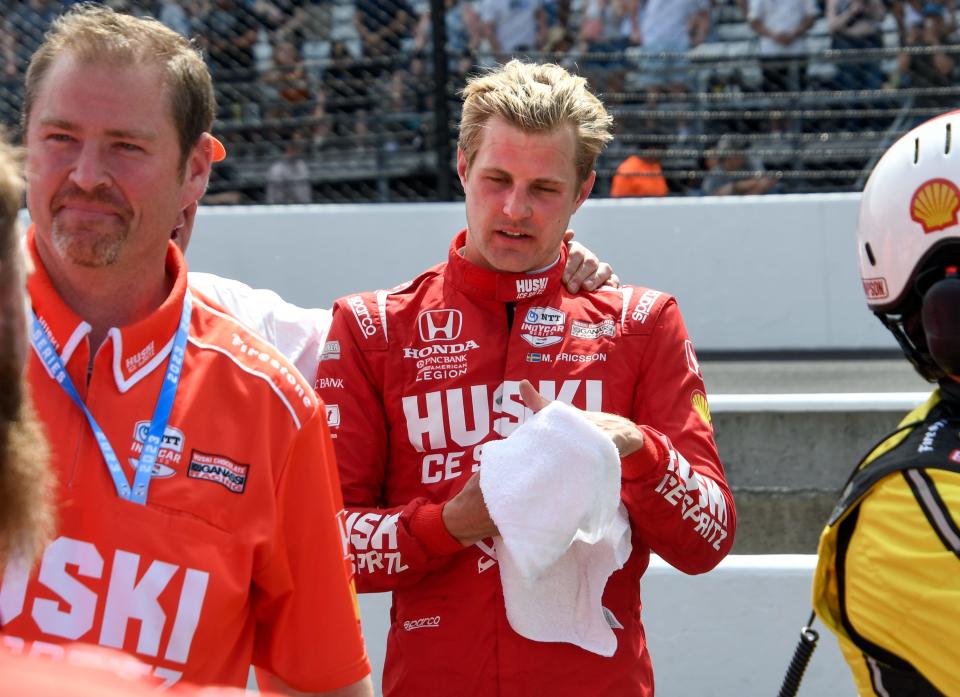Marcus Ericsson hoped Indy 500's late red flag rules would change. He's still disappointed
INDIANAPOLIS – In the wake of his frustration over the end of last year’s Indianapolis 500 and IndyCar race control’s lack of consistency compared to its late-race calls in 2020, all Marcus Ericsson wanted was some clarity. He hoped drivers and series officials could come to an agreement in the offseason, at least where the 500’s concerned, on exactly when race control would deem it “too late” to throw a red flag to try and preserve a green flag finish.
Ericsson’s wishes have not been granted.

“They might even do it NASCAR-style and add a couple laps,” joked the Andretti Global driver during media availability ahead of the Sonsio Grand Prix. Though the race will indeed run a maximum 500 miles -- no more and, barring rain, no less -- the quip reflects the frustrations of last year’s runner-up when it comes to the series’ unwillingness to give teams and drivers a sense of what to expect and how to strategize when coming into the final 10 laps of a close race.
In 2020, race control threw a yellow flag near the end of Lap 196 and defended their choice not to throw a red and in a post-race statement said that, essentially, there were too few laps to go through proper procedures and get back to green before reaching 500 miles. Fast forward three years, and just as Ericsson inched ahead of Josef Newgarden on a restart to open Lap 197, cars near the back began careening into each other.
An immediate yellow came, but the choice to red flag the race only came once the field was already more than halfway through Lap 198. The green flag waved while the back of the pack was only barely out of the warmup lane to give Ericsson and Newgarden a one-lap duel for the Borg-Warner.
And under the current aero configurations, everyone – Ericsson included – knew the Chip Ganassi Racing driver was a sitting duck, that Newgarden would have little trouble blowing by on the backstraight and then fending off Ericsson the last half-lap.
From last year: Why IndyCar race control bungled Indy 500 red flag call
Numerous drivers said the partial-lap warmup to be unsafe, and virtually no one IndyStar spoke to in the days immediately after said they had expected the race to go red with so few laps left — even while knowing that race control has long pointed to its “abandonment of procedures” provision that allows race director Kyle Novak and stewards Arie Luyendyk and Max Papis to go off-script from the rulebook.
That provision no doubt still exists, and Ericsson says teams have been given no indication of a ‘no turning back’ mark in the race where a red flag couldn’t be called. Clearly, should caution-worthy contact happen on Laps 199 or 200, the leader at the time of the yellow can know they’ll soon be drinking milk. Any earlier and it’s anyone’s guess.
“The explanation is that in the last 15 laps, all bets are off,” Ericsson told reporters. “Whatever they want to do, they can do. That’s what they’re saying.
“They say they’ll do whatever it takes to finish under green, and I just think it would be nice for everybody to have a lap where everyone knows (there won’t be a red). I agree; we want to have a green finish, but sometimes, it’s a yellow finish. It’s happened so many times in the history of this race, right? It’s not like it’s unique to last year, like, ‘Oh, it’s going to be a yellow finish! That’s a disaster!’ This has happened so many times.”
Outlawing 'The Dragon': Recent winning Indy 500 move made illegal. How it'll be officiated is unclear.

Ericsson: No clarification a strategy hurdle
As Ericsson explained, the lack of direction in late-race situations makes it tough for teams to strategize when they’re at the front in the final 10 laps or so – especially with a car that is fairly susceptible to a pass for 1st-place with one lap or so to set up the run. During his post-race availability following his record-tying fourth 500 win in 2021, Helio Castroneves explained to reporters he’d passed then-race leader Alex Palou entering Turn 1 on Lap 199 – and not before – because he knew it would be too difficult for the Spaniard to recover and execute a pass.
In Ericsson’s case, drivers knew you didn’t want to be the leader barreling into Turn 1 on green flag conditions – to the level that the Ganassi driver admitted after the race that during the third and final green flag, he toyed with the idea of letting Newgarden pass him immediately on the restart, in hopes he could pass him back on the backstraight.
That’s how hopeless he felt.
Ericsson after controversial 500 finish: 'I don't think it's the right way to end the race'
Had he known going into the second of three red flag restarts that a complete stoppage could still be possible, he told reporters last week he might not have tried so hard to get past Newgarden immediately following the drop of the green and instead held serve in 2nd-place, waiting to see if the field avoided instant carnage then lined up a hopeful last-lap pass instead.
He did what he did because Ericsson, like so many, presumed such a pass would either give him the instant lead and turn into a back-and-forth between he and Newgarden to close; or he’d nudge ahead and see a version of bumper cars in his rearview mirror, soon see a yellow and be able to cruise past the checkered flag and onto the Victory Podium.
With some sort of late-race protocol, drivers like Ericsson can know what they’re risking when they are – or aren’t – choosing to make a pass at a certain point in the closing stint. It becomes a game of strategy, risk and, inherently, a little luck. As things currently stand, and as recent history has played out – including series officials offering reasons as to why 2020 played out as it did that were notably omitted three years prior – you may be better to be lucky than right.
This article originally appeared on Indianapolis Star: Marcus Ericsson disappointed in no changes to Indy 500 red flag rules

